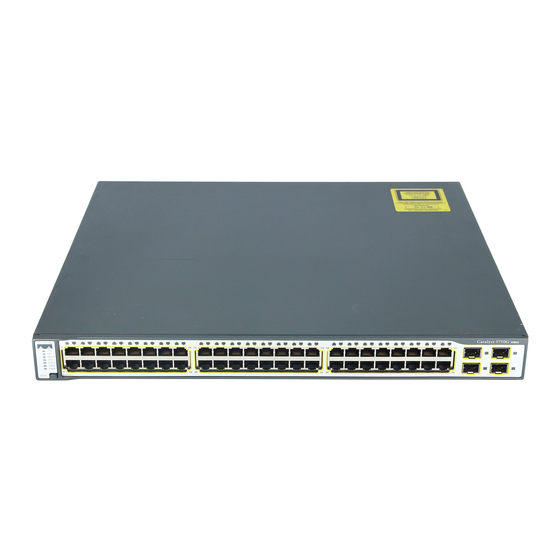Cisco 3750G-12S-E - Catalyst Switch - Stackable Gegevensblad - Pagina 6
Blader online of download pdf Gegevensblad voor {categorie_naam} Cisco 3750G-12S-E - Catalyst Switch - Stackable. Cisco 3750G-12S-E - Catalyst Switch - Stackable 23 pagina's. Ios software release 12.1(14)ea1
Ook voor Cisco 3750G-12S-E - Catalyst Switch - Stackable: Product Bulletin (5 pagina's), Product ondersteunings bulletin (6 pagina's), Product ondersteunings bulletin (6 pagina's)

Table 1
Product Features and Benefits (Continued)
Feature
High-performance IP Routing
All contents are Copyright © 1992–2004 Cisco Systems, Inc. All rights reserved. Important Notices and Privacy Statement.
Benefit
• Per VLAN Rapid Spanning Tree (PVRST+) allows rapid spanning-tree
reconvergence on a per-VLAN spanning-tree basis, without requiring the
implementation of spanning-tree instances.
• Cisco Hot Standby Router Protocol (HSRP) is supported to create redundant,
failsafe routing topologies.
• Command-switch redundancy enabled in Cisco CMS Software allows
designation of a backup command switch that takes over cluster management
functions if the primary command switch fails.
• UniDirectional Link Detection (UDLD) and Aggressive UDLD allow unidirectional
links caused by incorrect fiber-optic wiring or port faults to be detected and
disabled on fiber-optic interfaces.
• Switch port auto-recovery (errdisable) automatically attempts to re-enable a link
that is disabled due to a network error.
• Cisco Redundant Power System 675 (RPS 675) support provides superior
power-source redundancy for up to 6 Cisco networking devices, resulting in
improved fault tolerance and network uptime.
• Equal-cost routing for load balancing and redundancy.
• Bandwidth aggregation up to 16 Gbps through 10 Gigabit Etherchannel
technology, 8 Gbps through Gigabit EtherChannel technology, and up to
800 Mbps through Fast EtherChannel technology enhances fault tolerance
and offers higher-speed aggregated bandwidth between switches and to
routers and individual servers.
• Uplink bandwidth can be easily upgraded by adding a 10 Gigabit Ethernet
version to a wiring closet stack and replace the one Gigabit Ethernet uplinks
with 10 Gigabit Ethernet without having to change fiber pairs.
• Cisco Express Forwarding hardware routing architecture delivers extremely
high-performance IP routing.
• Basic IP unicast routing protocols (static, Routing Information Protocol Version 1
[RIPv1], and RIPv2) are supported for small-network routing applications.
• IPv6 routing support in hardware for maximum performance in the future.
• Advanced IP unicast routing protocols (Open Shortest Path First [OSPF], Interior
Gateway Routing Protocol [IGRP], Enhanced IGRP [EIGRP], and Border Gateway
Protocol Version 4 [BGPv4]) are supported for load balancing and constructing
scalable LANs. Enhanced Multilayer Software Image (EMI) is required.
• Policy-based routing (PBR) allows superior control by enabling flow redirection
regardless of the routing protocol configured. EMI is required.
• Hot Standby Routing Protocol (HSRP) provides dynamic load balancing and
failover for routed links, up to 32 HSRP links supported per unit or stack.
• Inter-VLAN IP routing for full Layer 3 routing between 2 or more VLANs.
• Protocol-Independent Multicast (PIM) for IP multicast routing is supported,
including PIM sparse mode (PIM-SM), PIM dense mode (PIM-DM), and PIM
sparse-dense mode. EMI is required.
• Distance Vector Multicast Routing Protocol (DVMRP) tunneling interconnects 2
multicast-enabled networks across non-multicast networks. EMI is required.
• Fallback bridging forwards non-IP traffic between 2 or more VLANs. EMI
is required.
• Routing is enabled across the stack.
• 128 switch virtual interfaces (SVIs) are recommended. Maximum of 1000 are
supported. (depends on the number of routes and multicast entries). 468 routed
ports are supported per stack.
Cisco Systems, Inc.
Page 6 of 22
